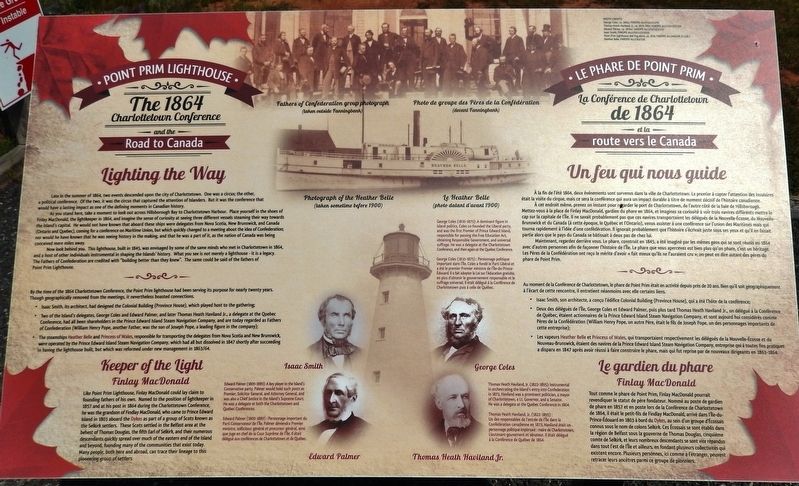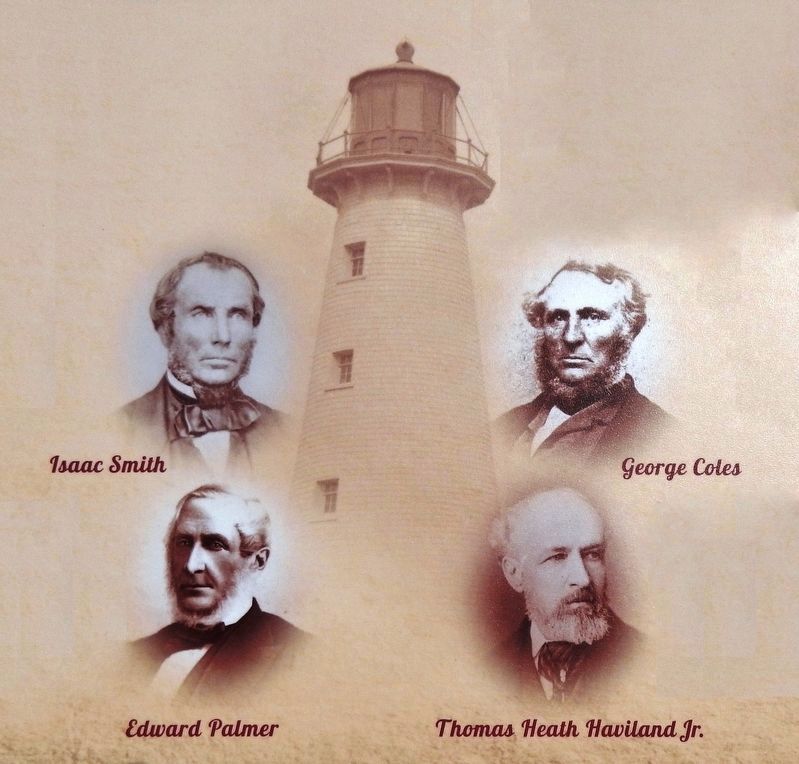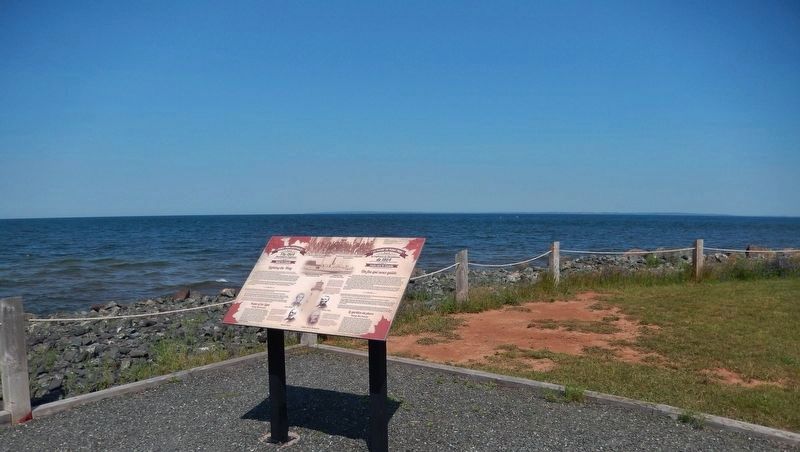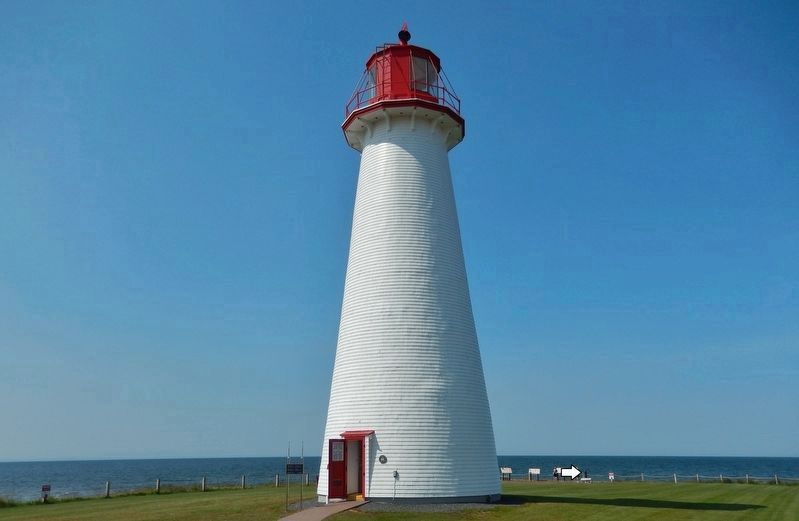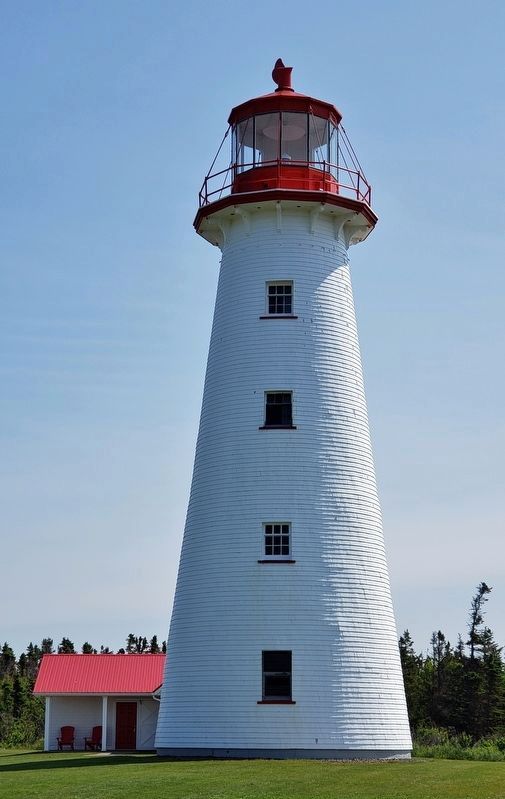Belfast in Queens County, Prince Edward Island — The Atlantic Provinces (North America)
The 1864 Charlottetown Conference / La Conférence de Charlottetown de 1864
Lighting the Way / Un Feu qui Nous Guide
Inscription.
Late in the summer of 1864, two events descended upon the city of Charlottetown. One was a circus; the other, a political conference. Of the two, it was the circus that captured the attention of Islanders. But it was the conference that would have a lasting impact as one of the defining moments in Canadian history.
As you stand here, take a moment to look out across Hillsborough Bay to Charlottetown Harbour. Place yourself in the shoes of Finlay MacDonald, the lightkeeper in 1864, and imagine the sense of curiosity at seeing three different vessels steaming their way towards the Island's capital. He would not have known that aboard these ships were delegates from Nova Scotia, New Brunswick, and Canada (Ontario and Quebec), coming for a conference on Maritime Union, but which quickly changed to a meeting about the idea of Confederation; nor would he have known that he was seeing history in the making, and that he was a part of it, as the nation of Canada was being conceived mere miles away.
Now look behind you. This lighthouse, built in 1845, was envisaged by some of the same minds who met in Charlottetown in 1864, and a host of other individuals instrumental in shaping the Islands' history. What you see is not merely a lighthouse - it is a legacy. The Fathers of Confederation are credited with "building better than they knew". The same could be said of the fathers of Point Prim Lighthouse.
By the time of the 1864 Charlottetown Conference, the Point Prim lighthouse had been serving its purpose for nearly twenty years. Though geographically removed from the meetings, it nevertheless boasted connections.
• Isaac Smith, its architect, had designed the Colonial Building (Province House), which played host to the gathering;
• Two of the Island's delegates, George Coles and Edward Palmer, and later Thomas Heath Haviland Jr., a delegate at the Quebec Conference, had all been shareholders in the Prince Edward Island Steam Navigation Company, and are today regarded as Fathers of Confederation (William Henry Pope, another Father, was the son of Joseph Pope, a leading figure in the company);
• The steamships Heather Belle and Princess of Wales, responsible for transporting the delegates from Nova Scotia and New Brunswick, were operated by the Prince Edward Island Steam Navigation Company, which had all but dissolved in 1847 shortly after succeeding in having the lighthouse built, but which was reformed under new management
in 1863/64.
Keeper of the Light • Finlay MacDonald
Like Point Prim Lighthouse, Finlay MacDonald could lay claim to founding fathers of his own. Named to the position of lightkeeper in 1857 and at his post in 1864 during the Charlottetown Conference, he was the grandson of Findlay MacDonald, who came to Prince Edward Island in 1803 aboard the Dykes as part of a group of Scots known as the Selkirk settlers. These Scots settled in the Belfast area at the behest of Thomas Douglas, the fifth Earl of Selkirk, and their numerous descendants quickly spread over much of the eastern end of the Island and beyond, founding many of the communities that exist today. Many people, both here and abroad, can trace their lineage to this pioneering group of settlers.
George Coles (1810-1875)
A dominant figure in Island politics, Coles co-founded the Liberal party, and was the first Premier of Prince Edward Island, responsible for passing the Free Education Act, obtaining Responsible Government, and universal suffrage. He was a delegate at the Charlottetown Conference, and then again at the Quebec Conference.
Edward Palmer (1809-1889)
A key player in the Island’s Conservative party, Palmer would hold such ports as Premier, Solicitor General, and Attorney General, and was also a Chief Justice in the Island's Supreme Court. He was a
delegate at both the Charlottetown and Quebec Conferences.
Thomas Heath Haviland, Jr. (1822-1895)
Instrumental in orchestrating the Island's entry into Confederation in 1873, Haviland was a prominent politician, a mayor of Charlottetown, a Lt. Governor, and a Senator. He was a delegate at the Quebec Conference in 1864.
À la fin de l'été 1864, deux événements sont survenus dans la ville de Charlottetown. Le premier à capter l'attention des insulaires était la visite du cirque, mais ce sera la conférence qui aura un impact durable à titre de moment décisif de l'histoire canadienne.
À cet endroit même, prenez un instant pour regarder le port de Charlottetown, de l'autre côté de la baie de Hillsborough. Mettez-vous à la place de Finlay MacDonald, gardien du phare en 1864, et imaginez sa curiosité à voir trois navires différents mettre le cap sur la capitale de l'Île. Il ne savait probablement pas que ces navires transportaient les délégués de la Nouvelle-Écosse, du Nouveau-Brunswick et du Canada (à cette époque, le Québec et l'Ontario), venus assister à une conférence sur l'union des Maritimes mais qui tourna rapidement à l'idée d'une confédération. Il ignorait probablement que l'histoire s'écrivait juste sous ses yeux et qu'il en faisait partie alors que le pays du Canada se bâtissait à deux pas de chez lui.
Maintenant,
regardez derrière vous. Le phare, construit en 1845, a été imaginé par les mêmes gens qui se sont réunis en 1864 avec d'autres personnes afin de façonner l'histoire de l'Île. Le phare que vous apercevez est bien plus qu'un phare, c'est un héritage. Les Pères de la Confédération ont reçu le mérite d'avoir « fait mieux qu'ils ne l'auraient cru »; on peut en dire autant des pères du phare de Point Prim.
Au moment de la Conférence de Charlottetown, le phare de Point Prim était en activité depuis près de 20 ans. Bien qu'il soit géographiquement à l'écart de cette rencontre, il entretient néanmoins avec elle certains liens.
• Isaac Smith, son architecte, a conçu l'édifice Colonial Building (Province House), qui a été l'hôte de la conférence;
• Deux des délégués de l'Île, George Coles et Edward Palmer, puis plus tard Thomas Heath Haviland Jr., un délégué à la Conférence de Québec, étaient actionnaires de la Prince Edward Island Steam Navigation Company, et sont aujourd hui considérés comme Pères de la Confédération (William Henry Pope, un autre Père, était le fils de Joseph Pope, un des personnages importants de cette entreprise);
• Les vapeurs Heather Belle et Princess of Wales, qui transportaient respectivement les délégués de la Nouvelle-Écosse et du Nouveau-Brunswick, étaient des navires de la Prince Edward Island Steam Navigation
Company, entreprise qui à toutes fins pratiques a disparu en 1847 après avoir réussi à faire construire le phare, mais qui fut reprise par de nouveaux dirigeants en 1863-1864.
Le gardien du phare • Finlay MacDonald
Tout comme le phare de Point Prim, Finlay MacDonald pourrait revendiquer le statut de père fondateur. Nommé au poste de gardien de phare en 1857 et en poste lors de la Conférence de Charlottetown de 1864, il était le petit-fils de Findlay MacDonald, arrivé dans l’Île-du-Prince-Édouard en 1803 à bord du Dykes, au sein d'un groupe d'Écossais connus sous le nom de colons Selkirk. Ces Écossais se sont établis dans la région de Belfast sous la gouverne de Thomas Douglas, cinquième comte de Selkirk, et leurs nombreux descendants se sont vite répandus dans tout l'est de l'Île et ailleurs, en fondant plusieurs collectivités qui existent encore. Plusieurs personnes, ici comme à l'étranger, peuvent retracer leurs ancêtres parmi ce groupe de pionniers.
George Coles (1810-1875)
Personnage politique important dans l'Île, Coles a fondé le Parti Libéral et a été le premier Premier ministre l’Île-du-Prince-Édouard. Il a fait adopter la Loi sur l'éducation gratuite, en plus d'obtenir le gouvernement responsable et le suffrage universel. Il était délégué à la Conférence de Charlottetown puis à celle de Québec.
Edward Palmer (1809-1889)
Personnage
important du Parti Conservateur de l'Île, Palmer deviendra Premier ministre, solliciteur général et procureur général, ainsi que juge en chef de la Cour Suprême de l'île. Il était délégué aux conférences de Charlottetown et de Québec.
Thomas Heath Haviland, Jr. (1822-1895)
Un des responsables de l'entrée de l'Île dans la Confédération canadienne en 1873, Haviland était un personnage politique important : maire de Charlottetown, Lieutenant-gouvernent et sénateur. Il était délégué à la Conférence de Québec de 1864.
Topics and series. This historical marker is listed in these topic lists: Colonial Era • Government & Politics • Settlements & Settlers • Waterways & Vessels. In addition, it is included in the Lighthouses series list. A significant historical year for this entry is 1864.
Location. 46° 3.004′ N, 63° 2.38′ W. Marker is in Belfast, Prince Edward Island, in Queens County. Marker can be reached from Point Prim Road (Prince Edward Island Route 209) 11 kilometers west of Trans-Canada Highway (National Route 1). Marker is located at the southwest corner of the Point Prim Lighthouse grounds, about 50 yards west of the lighthouse, overlooking Northumberland Strait. Touch for map. Marker is at or near this postal address: 2147 Point Prim Road, Belfast PE C0A 1A0, Canada. Touch for directions.
Other nearby markers. At least 8 other markers are within 18 kilometers of this marker, measured as the crow flies
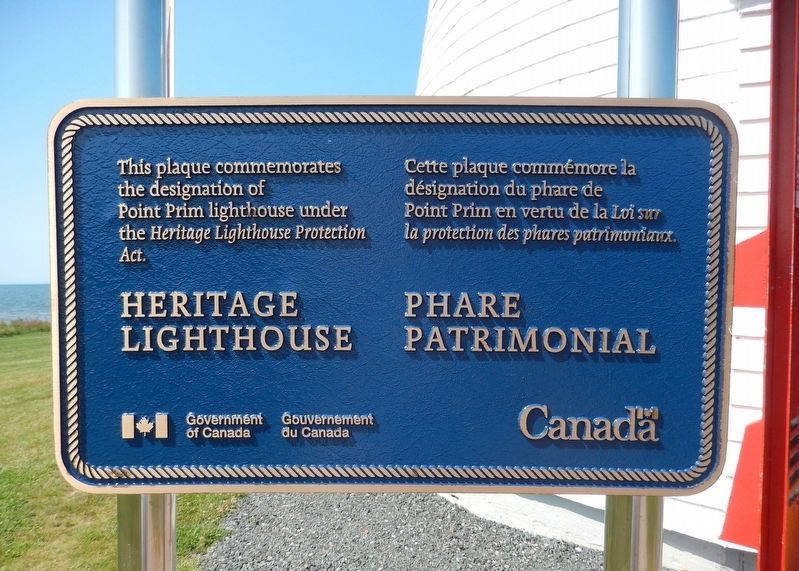
Photographed By Cosmos Mariner, July 16, 2019
7. Heritage Lighthouse / Phare Patrimonial
(plaque mounted beside lighthouse entrance)
(plaque mounted beside lighthouse entrance)
This plaque commemorates the designation of Point Prim lighthouse under the Heritage Lighthouse Protection Act.
Cette plaque commémore la désignation du phare de Point Prim en vertu de la Loi sur la protection des phares patrimoniaux.
Cette plaque commémore la désignation du phare de Point Prim en vertu de la Loi sur la protection des phares patrimoniaux.
Related markers. Click here for a list of markers that are related to this marker. Point Prim Lighthouse, Belfast, PE
Credits. This page was last revised on September 29, 2019. It was originally submitted on September 28, 2019, by Cosmos Mariner of Cape Canaveral, Florida. This page has been viewed 201 times since then and 26 times this year. Photos: 1. submitted on September 28, 2019, by Cosmos Mariner of Cape Canaveral, Florida. 2, 3, 4, 5, 6, 7. submitted on September 29, 2019, by Cosmos Mariner of Cape Canaveral, Florida.
